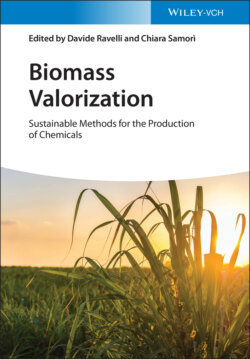Читать книгу Biomass Valorization - Группа авторов - Страница 22
2.1 Introduction
ОглавлениеBiomass consists of one or more of high‐molecular‐weight carbohydrates, such as lignin (aromatic polymers), lipids, and proteins, and is a viable renewable alternative substrate (to fossil materials) for the industrial synthesis of bulk and fine chemicals [1–5]. Model reactions of individual substances that constitute biomass show that all native (macro)molecules are convertible into a large range of low‐molecular‐weight, value‐added products through a variety of acid‐catalyzed processing steps [1–13]. Catalysis is a major pillar upon which a major portion of the global chemical industry rests, and it is estimated that catalysts are used to generate nearly 75% of all chemicals produced worldwide [14]. The value and role of catalysts in the industry cannot be overstated. The valorization of biomass is no exception [1–5].
As explained in Section 2.1.1., lignocellulose can be considered to be the main, or only, appropriate substrate for large‐scale, acid‐catalyzed processing into platform chemicals, and it accordingly holds significant industrial potential [4]. The net production of terrestrial plant cell walls alone has been estimated to be 150–170 billion tons per year [15]. There already exists a very significant industry revolving around lignocellulosic materials [16]. Of these, forestry is one of the largest with a mature global supply chain from sustainable forests through to saw mills, pulp and paper manufacturing, and distribution networks. This industry, along with paper and cardboard recycling, is ready and poised to supply large volumes of feedstocks to industries focused on the valorization of lignocellulose to produce platform and other chemicals. Logging slash (the side branches and other woody debris left during logging operations) would be an excellent source material for industrial processes, given the volumes of its production, the zero or negative cost associated with slash, and the existing environmental issues relating to slash [17]. Other potential high‐volume sources of materials for the sustainable acid‐catalyzed production of green chemicals, without disrupting any existing business or facilities, include waste streams of marine and fresh water algae aquaculture and nonedible and waste residues from agriculture, horticulture, and food production [4].
A goal of this chapter is to define efficient methods for the acid‐catalyzed conversion of biomass into targeted value‐added products. It analyzes current technologies, underpinning the relation of the method to the sustainability of the process. It also discusses the chemistry accompanying catalytic transformations of carbohydrates and lignin into specific products, defining the overall role of the acidic catalyst, solvent, and processing parameters. This is to strengthen the foundation for future sustainable developments of biorefineries.
